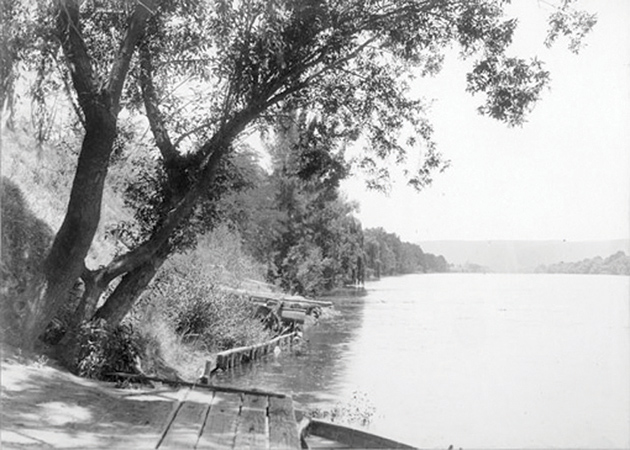Bennett’s Wharf Nepean River – courtesy of Penrith Library
By Lyn Forde – President/Research Officer of St Marys & District Historical Society Inc.
IT is true that the closeness of water and the absence of not being able to swim, does over the years, take its toll on people at our local rivers and creeks. So, it was in August 1897 an inquest was held by Coroner John King Lethbridge at Nepean Cottage Hospital on the body of John Walter Pearson who was found in the Nepean River. A jury of twelve men viewed the body in the morgue and evidence was taken. John worked for baker John Easterbrook in High Street, Penrith and at the inquest his daughter Matilda testified that she saw the body and recognise it as John Pearson who was employed by her father to deliver bread. Matilda managed her father’s business, but she had complaints about bills not being delivered and in July some customers said they had paid the change to John, but he hadn’t given her the sale money and she had spoken to him and ask him to keep things correctly. She said he appeared to be the same as usual and there was nothing sad about him. Before he left she told him that she would send her brother-in-law Frank Earp with him to deliver the bills and collect the money on the Emu Plains and Castlereagh side because John’s sight was not good and he said, “Very well”. She knew that his sight had been failing lately but he never complained to her about it. John left as usual in the baker’s cart on his rounds that morning and she gave him five shillings for change but did not see him alive again. Matilda said that she asked Frank to go out with the bills not on account of the shortage of the money but the fact that having Frank delivering the bills to her would show whether there was any shortage. He was a single man and had no relatives that she knew of here in Australia, but he had friends in Sydney, and she thought he was born in Kent in England. He just turned 33 years of age and had been in her father’s employ for about two years. He would occasionally take a glass or two of liquor but never got drunk and had not been drinking lately. She asked him if it would be better to have a spell, but he said no as he would rather stay on and do his work. She said she saw the cart when it came back to the bakery that morning and there were seven loaves missing and he had only been absent about an hour when she heard of his death. The next person to be sworn in was a boat proprietor residing on the banks of the Nepean River in Penrith named William James Rowe who said he had seen the dead body of John Pearson in the morgue and recognise him being in the employ of John Easterbrook and early that morning John came to his place with a loaf of bread and he gave him 6/- (sixpence) and he noticed that when John was giving him the change he was surprised to see him so short sighted. When he asked him the reason he said that the wheel of the cart had come off and he was thrown on his head and that had affected his eyes and head. John asked if Frank Earp had gone by, but he hadn’t so John drove away towards the bridge where he saw Frank coming along the road and reading something but couldn’t get his attention as he was on horseback. Next to give evidence was Francis William Earp who said he was a baker who lived at Jamestown and John Easterbrook was his father-in-law and he had seen John’s body in the morgue and said he had spoken to him at his father-in-law’s premises that morning where he spoke to Matilda about some bills that he took to catch up to John as he left before him. He went towards the bridge in the direction of Emu Plains and spotted him about a quarter of a mile from the bridge and just leaving Rowe’s place and John was on the cart. He took the bills out of his pocket and was sorting them whilst riding along and was nearly opposite Fuller’s place when he saw the cart, but he did not see John and the reins were tied to the iron railing on the cart. He said he waited thinking he may have gone into Fuller’s or Thomas’s homes, so he went on over the bridge and waited but when he did not come he went back to see what was keeping him. Frank then went to Fuller’s and Thomas’ place to ask whether John had been there but was told John had not and Frank began to think something was wrong. With Mr Fuller they went down to the river to search but didn’t find John, so he walked up towards Rowe’s place where he found John floating face downwards in the water close to Mr Bennett’s wharf. Frank got into one of the boats and lifted him out of the water as high as he could and called to Mr Fuller who came and helped him to lift John into a boat, but he was quite dead. He reported the matter to the police and a Constable came and took charge of the body. Mr Sibley who owned Bennett’s wharf said that John was formerly employed by him and knew the place thoroughly and he had known John ever since he came to Penrith some five years ago, but he did not notice anything different in him when he hired a boat from him yesterday and he seemed to be the same. He knew John could not swim and often heard John say that he wished he could. The Coroner mentioned that John was fully dressed except for his hat that could not be found and his clothing was not disarranged. Dr Brady said John was a well-made young man and apparently well-nourished and found no marks on any part of the body and said that asphyxia by drowning as the cause of death. Sergeant Thorndike testified that he searched John’s box at Easterbrook’s and found a Lodge book and the will dated 20th March 1897 that read “This is to certify that I, John W Pearson having not feeling well for some little time and do not know what may happen to me any day, wish if I should die sometime I am at Mr Easterbrook’s and that he should receive my Lodge money after the last expenses is paid and that George Easterbrook receive all my personal effects. I would like (two people mentioned) to be notified of my death. This is all I need to say and up to the present it is my last wish. John Walter Pearson.” James Fred William Howarth testified – “I am Secretary of the Loyal Alexander Lodge No 188, Manchester Unity, I.O.O.F., and deceased was a member of our order, and was good on the books according to our rules and if he has no relatives or friends in the country who wish to bury him the lodge will do so and carry out all arrangements, and take the expenses out of the £30 which is coming to him and we are prepared to bury him at once”. The Coroner addressed the jury who brought in the following verdict: “We find that the deceased John Walter Pearson in the waters of the Nepean in the district of Penrith in August, 1897 was found dead without any marks of violence appearing on his body and we further find that his death was caused by suffocation by drowning, but how or by what means he came to be drowned there is not sufficient evidence for us to say.”.
Source: Nepean Times






